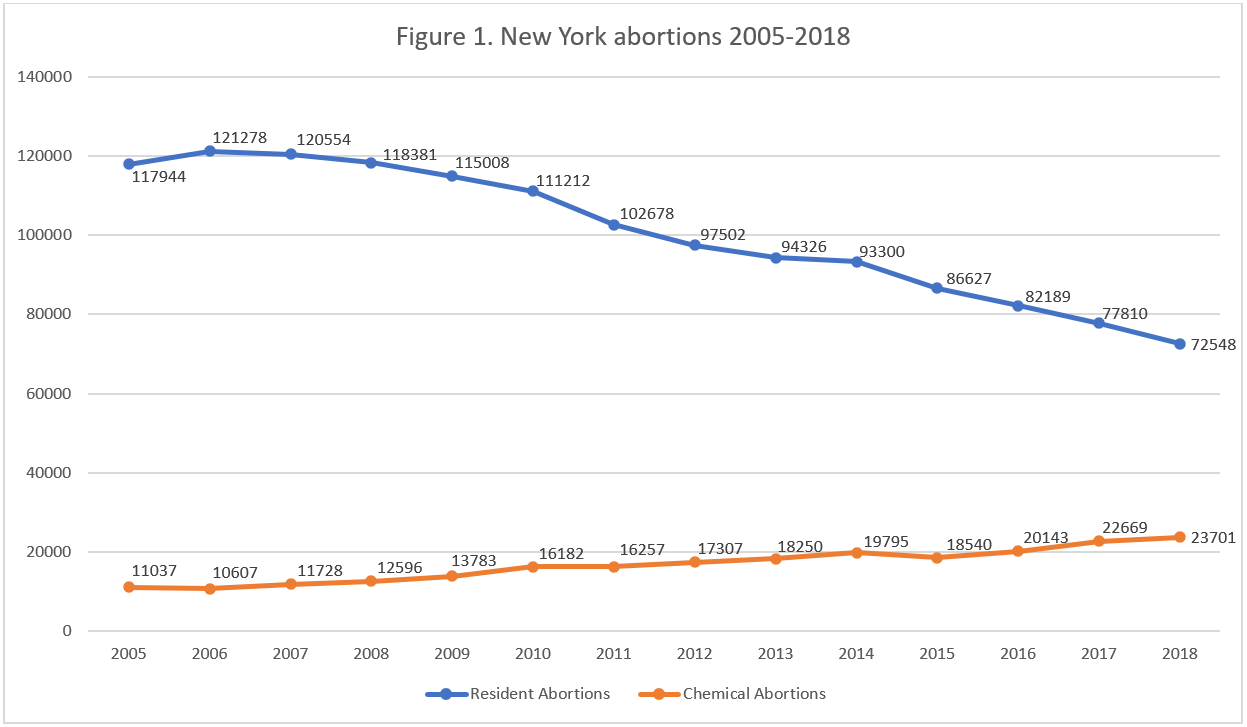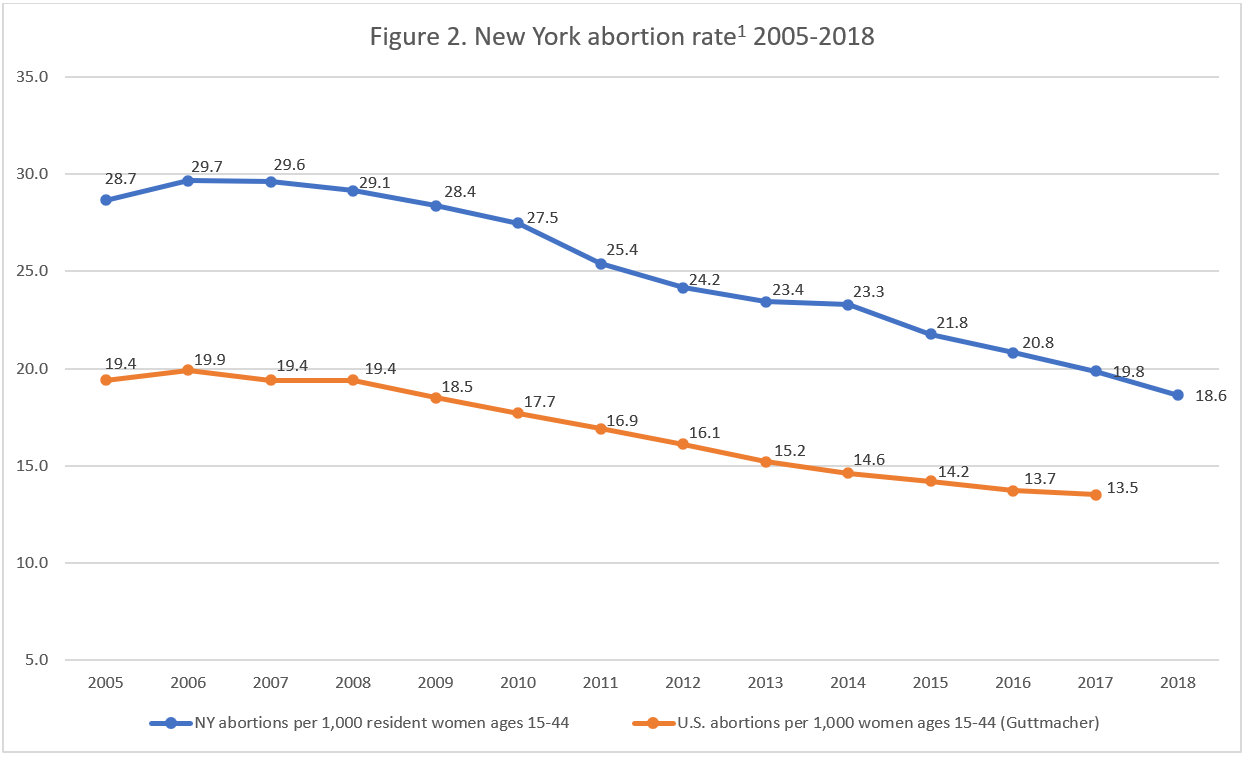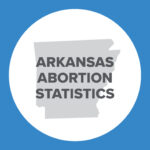Abortion Reporting: New York (2018)
New York’s abortion report for 2018 was published in January 2021. The report indicates that New York’s abortion rate declined between 2017 and 2018 but remains higher than the national rate.
Changes in New York Abortions, 2017-2018

The change in abortions and the abortion rate reflects abortions performed on New York residents only. The report does not include information on Planned Parenthood’s New York abortion market share.
Abortion Totals and Trends
There were 72,548 abortions reported to have been performed on New York residents in New York in 2018. Total resident abortions dropped by seven percent from 2017 to 2018, while chemical abortions performed on residents increased five percent. In 2018, chemical abortions made up 33 percent of the total. The Charlotte Lozier Institute (CLI) estimates that New York’s resident abortion rate was 18.6 abortions per 1,000 women ages 15 to 44, higher than the national rate (Fig. 2). New York’s state abortion report contains information for abortions performed on New York residents only, but national reports from the Centers for Disease Control and Prevention (CDC) show that the total number of abortions occurring in New York also fell by seven percent between 2017 and 2018.
State Report Summary
Of the abortions performed on New York residents, 65 percent were on women from New York City, and 35 percent were on women from the rest of the state. Nine percent of the abortions were on girls under the age of 20, including three percent on minors under the age of 18. Twenty-seven percent were on women ages 20 to 24, and 28 percent were obtained by women ages 25 to 29. Thirty-one percent of the abortions were performed on women in their thirties, and four percent were on women age 40 or older, while age was not reported for 155 abortions (0.2 percent).
Thirty-one percent of the abortions were performed on non-Hispanic black women, compared to 22 percent on non-Hispanic white women and seven percent on non-Hispanic women of other races. Twenty-four percent of the abortions were performed on Hispanic women, and 16 percent were on women of unknown race. Overall, the non-Hispanic black abortion rate was more than four times the non-Hispanic white rate, although the difference may be even greater since many of the abortions with unreported race were performed in New York City, which has a larger population of non-Hispanic black women than does upstate New York. Thirty-eight percent of the abortions were obtained by women with no previous abortions, while 21 percent were on women with one prior abortion and 30 percent on women with two or more. The number of previous abortions, if any, was not reported for 11 percent of the abortions.
Almost two-thirds of the abortions (66 percent) occurred earlier than nine weeks of gestation. Thirteen percent were reported between nine and 10 weeks, and six percent were performed between 11 and 12 weeks. Four percent were performed between 13 and 15 weeks of gestation, dropping to three percent between 16 and 19 weeks. Two percent of the abortions were performed at 20 weeks of gestation or later, similar to the previous year. Gestational age was not reported for six percent of the abortions.
Well over half the abortions (57 percent) were performed using suction curettage. Thirty-three percent were chemical abortions, and seven percent were dilation and evacuation procedures. Four percent of the abortions were performed via dilation and curettage. There were 121 saline injection abortions, 68 prostaglandin abortions, and 573 other, unspecified procedures. Multiple methods can be reported for a single abortion, so the reported methods sum to more than the total number of abortions performed on New York residents.
Nine percent of the abortions occurred in hospitals, and 91 percent were performed in other facilities. The type of facility was not reported for 60 abortions. Nearly half the abortions (49 percent) were funded using taxpayer dollars. Four percent were covered by HMOs, and 29 percent were funded by some other insurance. Thirteen percent were self-pay, and almost one percent were funded using multiple payment sources. The method of payment was not reported for four percent of the abortions.
Abortion Centers in New York City and Upstate New York
In 2017, the Guttmacher Institute reported that there were 252 abortion facilities in New York, of which 113 were clinics. In 2018, the Charlotte Lozier Institute identified 104 New York abortion centers, although it was not clear if all of these met Guttmacher’s definition of a “clinic.”
In 2018, Planned Parenthood centers were concentrated in upstate New York, while other abortion centers were predominant in the city. Of the abortion facilities identified by CLI, 45 were located in New York City, and 59 were located in the rest of the state. Planned Parenthood’s four New York City centers made up approximately nine percent of the New York City abortion facilities found by CLI, while Planned Parenthood’s 45 upstate centers composed 76 percent of the upstate abortion facilities that CLI discovered. However, New York does not report the number of abortions performed at each abortion center, and Planned Parenthood’s Manhattan mega-center may have accounted for a disproportionate share of New York City abortions.
The decline in abortion between 2017 and 2018 was sharpest in New York City. New York City’s resident abortion rate dropped by eight percent in 2018, compared to the abortion rate in the rest of the state, which fell by just three percent. However, the upstate abortion rate (12.6 abortions per 1,000 women ages 15 to 44) was still much lower than the New York City abortion rate (25.3).
State Ranking
In CLI’s 2016 paper on abortion reporting across the United States, New York State’s reporting was ranked at 39th best. To improve its reporting, New York could ensure that all abortions are reported and validate the data it receives. In 2017, Guttmacher’s estimate of the abortions performed in New York was 27 percent higher than the total New York reported to the Centers for Disease Control and Prevention, and New York data was excluded from several tables in the CDC report due to failure to meet reporting standards. By strengthening its abortion reporting system, New York could provide a more accurate understanding of abortion in the state.


- Rates were calculated by CLI using the following formula: (abortions performed on New York residents ÷ number of resident women ages 15-44) x 1,000. Rates may differ slightly from previous CLI articles due to revised population estimates. Population estimates were obtained from the CDC WONDER database.
Click here to view reporting from:20212020201920172016
Click here to view reporting from New York City:202120202019

























